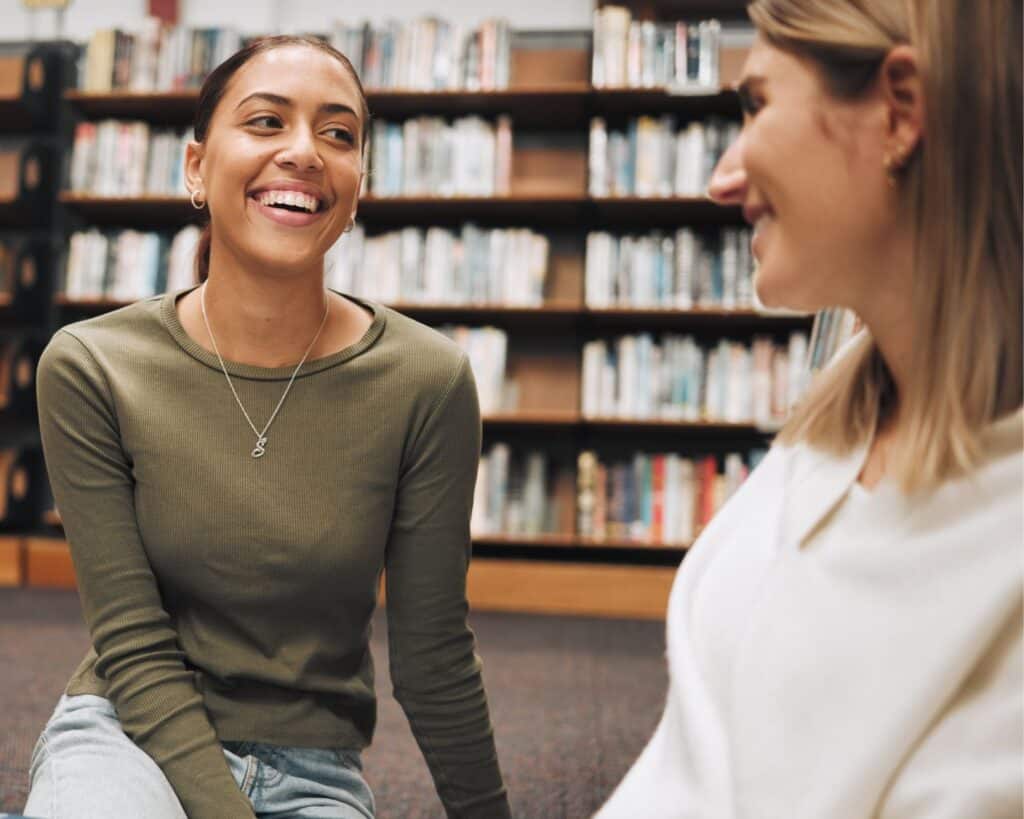An Overview of Peer Learning in Adult Classrooms
Peer learning in adult classrooms offers students opportunities to engage in structured activities that facilitate learning. In this powerful instructional method, students share ideas, think critically about issues, and draw conclusions about content in ways that reinforce concept retention. In this blog post, we’ll examine the benefits and challenges of peer learning in adult classrooms using the Think-Pair-Share and Fishbowl activities as examples.

Benefits of Peer-Learning In Adult Classrooms
Peer learning infiltrated adult education in the 1970s through Malcolm Knowles’ theory of andragogy. Knowles posited that adults are self-directed, bringing a wealth of practical experience to their learning environments. Researchers today support Knowles’ views and note the many benefits of peer learning for students:
- Integration of Content: Peer learning provides learners with opportunities to clarify their understanding of issues or concepts, fill in knowledge gaps through the information provided by other learners, and deepen the foundation of the constructs they use for thinking. Research shows learners who discuss concepts with peers perform better on written examinations.
- Personalization of Content: Personalization refers to a cognitive process in which learners connect information to themself, their personal life, and their needs in a way that causes them to care more about the topics they learn. Peer-learning activities naturally promote personalization and result in higher levels of learner engagement with content, instructors, and classmates. Learners are more motivated to participate and complete coursework.
- Improved Communication Skills: Peer-learning in adult classrooms allows learners to improve their mental agility by helping them refine their thinking and express their ideas. Participation requires learners to practice using the language of the massage discipline, improving their verbal fluency and professional vocabulary.
- Development of Social Intelligence: Social intelligence is a set of skills that allow people to get along well with others in various settings. Social intelligence skills include verbal fluency and conversational skills, knowledge of social roles, rules, and norms, empathy towards others, the ability to respond compassionately in challenging situations, and attentiveness to the impression one is making on others. Peer-learning activities provide opportunities for learners to investigate their assumptions, test their ideas against the reactions of their peers, and adjust their attitudes and values based on social feedback.
- Diagnostic for Learner Knowledge Gaps: Peer-learning activities require students to share their knowledge and thinking processes. When learners respond or try to explain their ideas, instructors can see the extent of their understanding or identify faulty construct formation. They can then correct or help the learner correct knowledge gaps.

Challenges with Peer-Learning in Adult Classrooms
We can minimize the challenges associated with peer learning through carefully constructed activities and proficient facilitation. It’s helpful to be aware of these challenges.
- Peer-Learning Gets Off Track: Without appropriate structure, clearly articulated goals, obvious end points, and teacher-summarized results, peer-learning activities may get off track, and learners disengage.
- Students Get Emotional: Peer-learning activities trigger various emotions in students. For example, a learner may feel threatened by another student’s assertive or aggressive stance or feel humiliated when the group criticizes an idea. As teachers, we must structure activities to avoid emotion-related pitfalls and be ready to manage student emotional expression as it arises.
- Balancing Student Voices: It takes pre-planning to balance student voices during peer-learning in adult classrooms. Some learners tend to monopolize conversations, while others remain quiet if they are not required to participate.
- Learners Create Confusion for Other Learners: Some learners frame their ideas in language, which creates confusion for other learners. A peer-learning activity may fall flat and lose steam if the particular learner, other learners, or the teacher can’t reframe and summarize the contribution of confusing statements for clarity.
- Learners Gravitate to Particular Roles: Some are natural leaders and repeatedly slip into leadership roles, while others are content to sit back during group work. Some learners are organizers and like to take notes, while others don’t. Learners benefit when they play various roles in a group process but will repeatedly play the same roles if teachers don’t intervene.
- Learners Disengage: Learners will often disengage if a peer-learning activity lacks appropriate structure or a clear focus. They may participate in side conversations, negatively challenge other people’s ideas, or sit quietly without sharing.
We’ll utilize time-tested and well-structured activities with clear guidelines to lessen these challenges. We’ll learn to mix individuals with varied skills and experiences to maximize learning outcomes and implement mechanisms for feedback. Finally, we’ll develop our facilitation skills to guide students to success. Let’s look at the directions for two populare peer-learning activities.

Example Peer-Learning Activities for Adult Classrooms
These two peer-learning formats are easily adaptable for both theoretical and practical content in massage classrooms. Think-Pair-Share is especially useful for brief discussion moments that break up a long lecture. At the same time, the Fishbowl is perfect for role-playing scenarios, sharing individual approaches to techniques, or practicing protocols such as conducting a health interview with a client.
Think-Pair-Share
Think-Pair-Share encourages individual reflection, allows students to test their ideas with a peer, and gives them the confidence to speak in front of the class. Additionally, students develop a deeper understanding of a topic through hearing multiple perspectives. These are the directions for conducting a Think-Pair-Share activity:
- Think: The instructor poses a question or problem to the class. It could be about a reading assignment, a theory, a real-world scenario, or insights about a topic from their personal life. The instructor gives students a few minutes to think and jot down their thoughts individually.
- Pair: Instructors ask students to pair up with a partner. Students discuss their reflections to compare, contrast, and synthesize their ideas.
- Share: After discussing in pairs, instructors call on each group to share their findings with the larger group or class. Students deepen their understanding by hearing the diverse range of perspectives their classmates generate.
The Fishbowl
The Fishbowl format facilitates in-depth discussion with active participation from all the students in your classroom. A smaller group of students discusses a topic while being observed by a larger group before they switch places. This format fosters improved attention, active listening, and deep thinking. These are the directions for conducting a fishbowl activity.
- Setup: Arrange chairs in two concentric circles. The active discussion takes place within the inner circle, while the outer circle is reserved for observers.
- Topic Selection: Choose a topic or question for discussion based on the content you’re studying in class. For example, “What is something you’ve learned about ethical principles that has changed the way you conduct massage sessions,” or “What do you know about the glenohumeral joint? Based on this knowledge, what techniques do you use in your shoulder massage?” or “Knowing about the impact of personal hygiene on disease transmission, what are some things you want to change about your daily hygiene practices?”
- Inner Circle Discussion: A group of students (usually 4-6) sits in the inner circle and discusses the chosen topic. They are the only ones allowed to speak during this phase.
- Outer Circle Observation: Students in the outer circle silently observe the discussion, taking notes on the arguments their classmates present.
- Switch Roles: After a set time (e.g., 10 minutes), rotate some or all students from the outer circle into the inner circle and vice versa.
- Whole Group Reflection: Once the rotations are complete, bring the whole class together to reflect on what they learned. Discuss the topic, share student observations, present new insights, and draw other conclusions.
For more peer-learning activities and downloadable directions, consider exploring The Traveling Hands Activity, Massage Round Robin, the Triad Format, and 7 Variations on Think-Pair-Share. Peer-learning also works in online environments.
In Closing
When thoughtfully structured and facilitated, peer learning in adult classrooms can transform the learning experience. Activities such as Think-Pair-Share and the Fishbowl encourage collaboration, critical thinking, and communication while helping learners personalize content and develop social intelligence. By anticipating potential challenges and guiding discussions with clear objectives, teachers can maximize the benefits of peer learning to enhance engagement, deepen understanding, and foster a more dynamic classroom environment.


